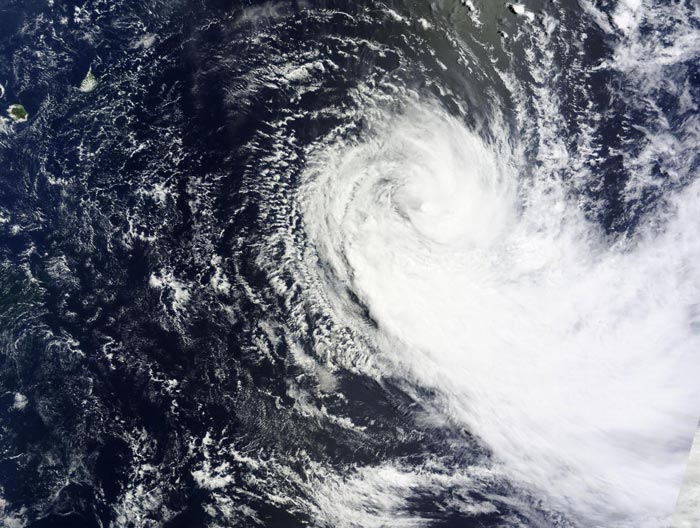NASA's Terra satellite sees Tropical Cyclone Glenda stretching out

NASA's Terra satellite captured a visible image of Glenda on Feb. 27 that revealed the bulk of storm's clouds pushed southeast of the center. Credit: NASA Goddard MODIS Rapid Response Team
When Terra passed over the Southern Indian Ocean on Feb. 27, the Moderate Resolution Imaging Spectroradiometer (MODIS) instrument captured a visible image of the storm.
In the image, the bulk of clouds associated with the storm appeared to be pushed southeast of the center and away from the islands of Mauritius and La Reunion.
The Joint Typhoon Warning Center (JTWC) noted today, Feb. 27, “animated multispectral satellite imagery shows the system has begun to show signs of elongation as the main convective bands are displaced eastward of a partially-exposed low-level circulation center.”
At 0900 UTC (4 a.m. EST), Glenda's maximum sustained winds had dropped to near 45 knots (51.7 mph/83.3 kph). Glenda was centered near 22.4 south latitude and 67.2 east longitude, about 573 nautical miles (659.4 miles/1,061 km) east-southeast of Port Louis, Mauritius. Glenda was moving to the south at 7 knots (8 mph/12.9 kph).
JTWC reported in their upper-level atmosphere analysis that Glenda is located in a “marginal environment with moderate vertical wind shear offset by excellent poleward outflow.”
By Saturday, Feb. 28, Glenda is expected to transition to an extra-tropical storm and become a cold-core system.
Media Contact
All latest news from the category: Earth Sciences
Earth Sciences (also referred to as Geosciences), which deals with basic issues surrounding our planet, plays a vital role in the area of energy and raw materials supply.
Earth Sciences comprises subjects such as geology, geography, geological informatics, paleontology, mineralogy, petrography, crystallography, geophysics, geodesy, glaciology, cartography, photogrammetry, meteorology and seismology, early-warning systems, earthquake research and polar research.
Newest articles

High-energy-density aqueous battery based on halogen multi-electron transfer
Traditional non-aqueous lithium-ion batteries have a high energy density, but their safety is compromised due to the flammable organic electrolytes they utilize. Aqueous batteries use water as the solvent for…

First-ever combined heart pump and pig kidney transplant
…gives new hope to patient with terminal illness. Surgeons at NYU Langone Health performed the first-ever combined mechanical heart pump and gene-edited pig kidney transplant surgery in a 54-year-old woman…

Biophysics: Testing how well biomarkers work
LMU researchers have developed a method to determine how reliably target proteins can be labeled using super-resolution fluorescence microscopy. Modern microscopy techniques make it possible to examine the inner workings…





















